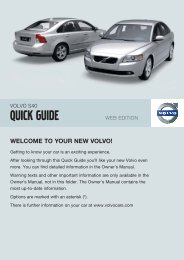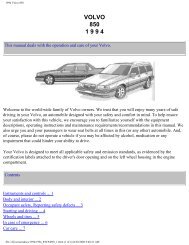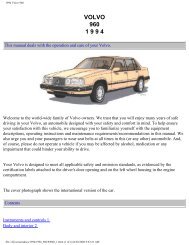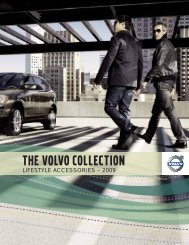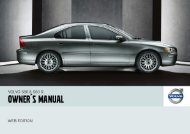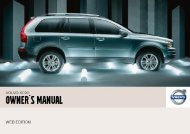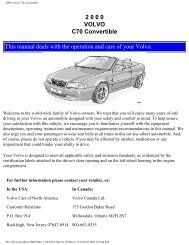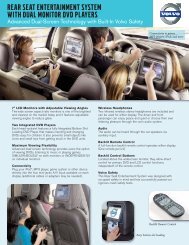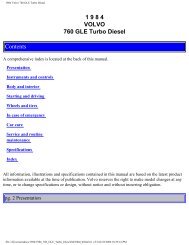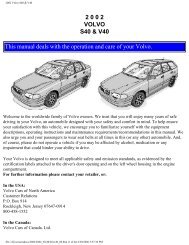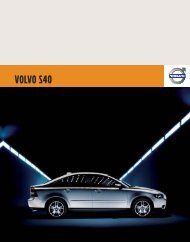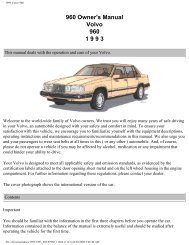V50 w646.book - ESD - Volvo
V50 w646.book - ESD - Volvo
V50 w646.book - ESD - Volvo
You also want an ePaper? Increase the reach of your titles
YUMPU automatically turns print PDFs into web optimized ePapers that Google loves.
06 Starting and driving<br />
Loading<br />
General<br />
The load capacity is affected by extra accessories<br />
mounted on the car, such as a towbar,<br />
load carriers, space box, the passengers’<br />
combined weight etc. as well as the load on<br />
the towball. The load capacity of the car is<br />
reduced by the number of passengers and<br />
their weight. For information on permitted<br />
weights, see page 233.<br />
WARNING<br />
The car’s driving characteristics change depending<br />
on how heavily it is loaded and how<br />
the load is distributed.<br />
Loading the cargo area<br />
Stop the engine and apply the parking brake<br />
when loading or unloading long objects. The<br />
gear lever or gear selector could be knocked<br />
out of position by long loads, which could set<br />
the car in motion.<br />
To increase the size of the cargo area, the<br />
head restraints can be removed and the<br />
seats folded down, see page 90.<br />
Place the load firmly against the backrest in<br />
front.<br />
• The head rests can be removed so that<br />
they are not damaged.<br />
• Put wide loads in the centre.<br />
• Heavy objects should be placed as low as<br />
possible. Avoid placing heavy loads on a<br />
lowered backrest.<br />
• Cover sharp edges with something soft to<br />
avoid damaging the upholstery or the<br />
large glass surface of the tailgate.<br />
• Secure all loads to the load retaining eyelets<br />
with straps or web lashings.<br />
WARNING<br />
A loose object weighing 20 kg can, in a<br />
frontal collision at a speed of 50 km/h, carry<br />
the impact of an item weighing 1000 kg.<br />
WARNING<br />
Never load cargo above the backrest.<br />
The protection provided by the inflatable<br />
curtain in the headlining may be compromised<br />
or eliminated by high loads.<br />
Always secure the load. During heavy braking<br />
the load may otherwise shift, causing<br />
personal injury.<br />
Load carriers<br />
To avoid damaging the car and for maximum<br />
possible safety while driving, it is recommended<br />
to use load carriers specially designed<br />
for your car by <strong>Volvo</strong>.<br />
Carefully follow the mounting instructions<br />
supplied with the carriers.<br />
• Check periodically that the load carriers<br />
and load are properly secured. Lash the<br />
load securely with retaining straps.<br />
• Distribute the load evenly over the load<br />
carriers. Put the heaviest objects at the<br />
bottom.<br />
• The size of the area exposed to the wind,<br />
and therefore fuel consumption, increase<br />
with the load’s size.<br />
• Drive gently. Avoid quick accelerations,<br />
heavy braking and taking curves hard.<br />
WARNING<br />
The car’s centre of gravity and driving characteristics<br />
are altered by roof loads.<br />
06<br />
149



